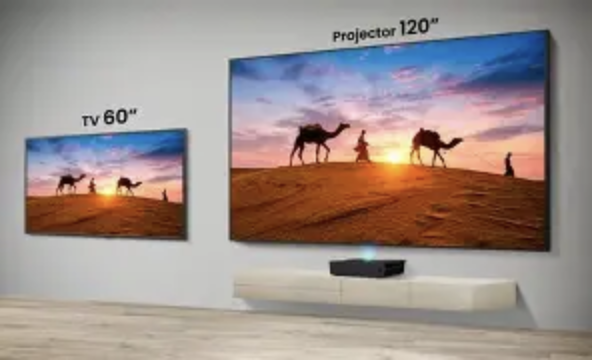Smart Projectors vs. Traditional TVs: The Living Room Crown
Beyond Pixels: The New Visual Paradigm
For a long time, traditional televisions have taken pride in their perfect pixel quality, but smart projectors are changing the way we experience entertainment. Picture a giant 150-inch screen on your wall, making movie nights feel like an IMAX experience—without a bulky frame interrupting your home design. Modern projectors now provide 4K resolution and HDR10+, rivaling OLED TVs in rich color, while laser technology means you won’t need to replace bulbs frequently. For those who are particular about viewing quality, it’s not just about the image size; it’s about creating a versatile theater atmosphere that adjusts to whatever you’re watching, from nature documentaries to fast-paced gaming at 120Hz.

Space as Luxury: Design for the Uncluttered Home
Affluent homeowners see space as a valuable asset, and this is where projectors shine. A compact, palm-sized gadget placed subtly on a shelf eliminates the requirement for a large TV stand, allowing more floor space for carefully selected furniture or artwork. Ultra-short-throw projectors can create 100-inch visuals from just a few inches away, eliminating unsightly wires and maintaining the elegance of minimalistic designs. In contrast, traditional televisions are static fixtures—impressive yet inflexible. For individuals who view their living rooms as both social areas and displays of style, projectors provide an unobtrusive appearance when turned off and a striking presence when in use.

Connectivity: The Ecosystem Advantage
Modern smart projectors serve as more than just screens; they act as key control centers. With built-in voice assistants, they effortlessly connect with smart home devices to dim lights or change the temperature at a word during movie nights. Higher-end versions allow for multiple devices to share content, enabling visitors to stream from their smartphones while ensuring 4K resolution is preserved. Even though traditional TVs come with smart features, they frequently limit users to specific app stores. For those who are tech-savvy and seek seamless compatibility, projectors offer a more customized and dynamic experience.

The Verdict: Adaptability Reigns
Both types of devices hold their value, but the choice of which is superior varies based on individual preferences. Traditional TVs perform well in bright environments since their screens handle glare better than projectors. On the other hand, projectors offer unique versatility for those who wish to easily switch a room into a gallery, cinema, or gaming area at any time. In today's world, where experiences are a form of luxury, smart projectors become more than just gadgets; they create the perfect setting for different life moments.
Additionally, improvements in projector technology are making performance differences less noticeable. Newer models provide greater brightness, allowing them to be used effectively in rooms with some light. Featuring 4K resolution and HDR support, they can produce images that compete with many premium TVs. Their convenience of portability further enhances their attraction, as they can be easily transported from one room to another or even set up outside for movie nights in the backyard. This capability allows any area to become a customized entertainment space without the limitations of a fixed screen size or complex installation.
(Writer:Lily)





